#uranometria
Text

Ulltisol | Sacred Spring Uranometria
June 2022
Bandcamp
#ulltisol#sacred spring uranometria#antifascist black metal#black metal#pagan black metal#experimental black metal#album art#canadian black metal#Tolkien
4 notes
·
View notes
Text
ʟᴏᴠɪɴɢ ᴋᴇɴᴊɪ ꜱᴀᴛᴏ ᴡᴏᴜʟᴅ ɪɴᴄʟᴜᴅᴇ...





-> synopsis: what would life be like to love the worlds baseball darling and secret superhero Ultraman, Kenji Sato?
-> pairing: kenji sato + black!gn!reader
-> from: ultraman: rising
-> contains: pure fluff, gender neutral, mentions of emiko and emi, 2nd person ('you', 'your', 'yours')
-> a/n: these animators need to stop making these kid movies with fine ass main characters bc whyyyyyyy is he so cute??? why do i wanna baby him in my arms and tell him everything will be okay? LET THIS MAN KNOW PEACE PLEASE!!!
-> join my taglist!
-> tags: @badass-dora-milaje @uranometrias @lees-chaotic-brain @jacuzziwaters

Kenji Sato who loves loves loooooovveeesss those subliminal couples pictures. The ‘private but not secret’ ones. They’re so aesthetically pleasing to him and they allow him to show you off to the world while still maintaining an air of privacy that he cherishes deeply from the media. Kenji is proud to call you his, and wants to show that in all ways possible.
Kenji Sato who is heavy on the couples jewelry. He’s already got a couple of notable pieces in his collection beforehand, and they only expand when you come into his life. In fact, the speculations of his love life come from the fact that people were noticing that he was wearing pieces from brands that were specifically designed for couples. Of course, when asked about it, he never goes into depth about it, and just recites how he thinks they look nice on him…and on someone else.
Kenji Sato who introduces you to his mom only after he’s sure that he wants to be serious with you. I have a feeling Emiko is the type of mom to get attached to their child’s partner in the sense of already viewing them as part of the family very early on, and Kenji wouldn’t want to get her hopes up if something were to happen - he can’t stand to see his mom upset. But when he does introduce you to his mom, you two become the best of friends! So definitely expect to be sent on girls day adventures by Kenji, cuz he’ll definitely be treating the two most important women in his life like royalty.
Kenji Sato who requires a lot of patience to deal - I mean, the man has a lot going on. Being the number one baseball player in the world, saving Japan from threats as Ultraman, and caring for the large kaiju baby Emi is more than a lot on anyone's plate. Kenji’s gonna need someone to understand that his schedule is never solid, and plans may fall through from time to time, and thats not because he’s not trying, but it’s because spontaneity runs his life and things can change at the drop of a hat, out of his control. It’s not the life he asked for, but it’s one he must take on.
Kenji Sato who doesn't exactly know how to bring up the topic of him being Ultraman, much less about Emi, early on in the relationship. I mean, how often do you tell someone that you're Japan's legendary hundred-foot tall superhero or that you're the surrogate parent to a twenty foot tall baby dragon kaiju? As much planning that he does on telling you, it ultimately happens in the worse way possible - you end up finding him mid-transition with Emi in tow...now that's gonna be an interesting story to tell. Spoiler: you stay with him, but now he's subjected to jokes about how is ego isn't the only thing that blows up to an enormous degree.
Kenji Sato who appreciates a partner that can not only deal with spontaneity, but is also rather spontaneous themselves. Surprise dates, random gifts, adventurous propositions out of the blue, I think those kind of things are right up his alley. He’s learned to live life in the moment and to the fullest, because it can be taken from you within an instant, and he wants to cherish every moment he has with you.
Kenji Sato who would spend his money on you religiously. He’ll sit in the dressing room with you as you try on armfuls of clothes, only to hand you his credit card at the end of the haul with a kiss to your temple, encouraging you to buy it all if you desire. And don't let you look at something too long in a display window, because he will have it shipped to your address in two business days. Endless trips post-baseball season in secluded locations so that the two of you can optimize the privacy you desperately crave.
Kenji Sato who’s a little bashful and nervous in the beginning, but eases into the relationship as time goes on. He doesn’t wanna mess up something so good that he has going on. Opening up takes some time, as he’s got some high walls that are hard to climb, but once you do get him to open up and bare his heart to you, don’t take it for granted. He doesn't do this to everyone, only the people he feels will truly return the care and compassion he has - so don’t prove him wrong.
Kenji Sato who seeks your comfort in the middle of the night when sleep evades him, leaving him restless and anxious. Most times, its about his mom and her disappearance, a mystery that's never left his mind. If you don't wake up to find him sitting up in bed deep in thought, or trying to tire himself out in a simulation, he finds comfort in just cuddling you, admiring your sleeping form, and talks about the most random things until the sun begins to peak over the horizon.
Kenji Sato who’s sort of in between the serious lover and the playful lover - he’s maturing in his emotions and how to deal with his past, learning how to communicate better and express himself healthily. Simultaneously, he’s a goofball and a jokester reliving a bit of his childhood in his love with you. Playful banter, jokes and teasing are equally as present as the late night talks and the deep conversations the two of you share.
Kenji Sato who tucks the chain that has his promise ring on it close to his chest, and on game days, rubs his thumb over the gold band for comfort and assurance before he heads up to bat. During championships, he'll ask you to kiss it for good luck, and when he wins, he of course accredits it to you being his 'good luck charm'.
Kenji Sato who loves deeply and fervently, with compassion and the entirety of his heart, who will do his duty and love you unconditionally an proudly while shielding you from the cruel and prying eyes of the public, letting you know time and time again that it will always be you he chooses, no matter what.

If you enjoyed, please leave a like, comment, and reblog for others to see! And don’t be shy to send in a request!
#black reader#black tumblr#ultraman#ultraman rising#kenji sato#sato kenji#ultraman ken#kenji ultraman#ken sato#kenji sato x you#kenji sato x reader#ken sato x you#ken sato x reader#kenji sato x black!reader#ken sato x black!reader
344 notes
·
View notes
Text
PART 2: CRIMINAL MINDS FIC RECS - (S.R and A.H)



(Link to part 1 and part 3)
Part 2 of my fic recs masterlist! Once again if I have included your work and you would like it removed please let me know!
A list of fics and authors I have absolutely loved reading!
Spencer Reid:
@dream-a-little-bigger-x - Annotations… Tongue Tied… I Think He Knows
@gubler-me-up - Ace… Too Much Caffeine… Confidential Information
@basketonthedoorstepofthefbi - Wingwoman
@cacoetheswriting - A Promise of Forever… For You and I… Unrequited Love & pt2
@fandom-imagines-stories - Trapped Secrets
@valentinedaughtler - The Seduction Bet
@latenightreadingpdf - Brewed Connections
@moon-light-jukebox - Our Boy… Morning Coffee… Learning Styles… Don’t go
@its-rach-writes - No Goodbyes
@a-simple-gaywitch - A Simple Act of Kindness… Ohana
@motherjoel - Hostile… Shameless… Fine Line pt1, pt2, pt3… Cup of Sugar… From Heaven Above
@mariasont - Sundress Season
@rebeccccccaaa - Poker Face
@spencessmile One Step At a Time
@ahopelessromantic - No Grave
@write-orflight - Like Real People Do (series)… Galileo (series)…Cherry Wine
@ddejavvu - Passive Aggressive
@luveline - Masterlist
@railingsofsorrow - 5 Hours Apart
@nereidprinc3ss - Drunk in Love
@atlabeth - Take My Breath Away
@galaxy-siren - I Thought I Lost You
@mggpleasedontlookhere - It Should’ve Been You pt1, pt2… Endgame pt1, pt2, pt3… Liar Liar pt1, pt2… To Be True, Not To Be True pt1, pt2, pt3
@qlossytbh - The Double Tuck… In Order To Protect You… Scratch Therapy… Especially If… Can We Have One?
@t1red-twilight - 1.5 Pints
@aliteralsemicolon - 3 Days, 4 Hours and 55 Minutes
@icarryitin - Effortless
@bellasprettywords - Loml
@uranometrias - Guilt’s a Motherfucker pt1, pt2
@aperrywilliams - That Wasn’t Fake
@marvelwitchergilmore - Cardigan
#fanfic#criminal minds#aaron hotchner#fanfic recs#spencer reid#spencer reid x reader#aaron hotch x reader#aaron hotchner x reader#fic recs#spencer reid imagine#aaron hotchner imagine#aaron hotch fanfiction#spencer reid fics#spencer reid fanfiction#criminal minds x reader#criminal minds imagine#writing#my fic#fluff#angst with a happy ending#angst#smut
307 notes
·
View notes
Text




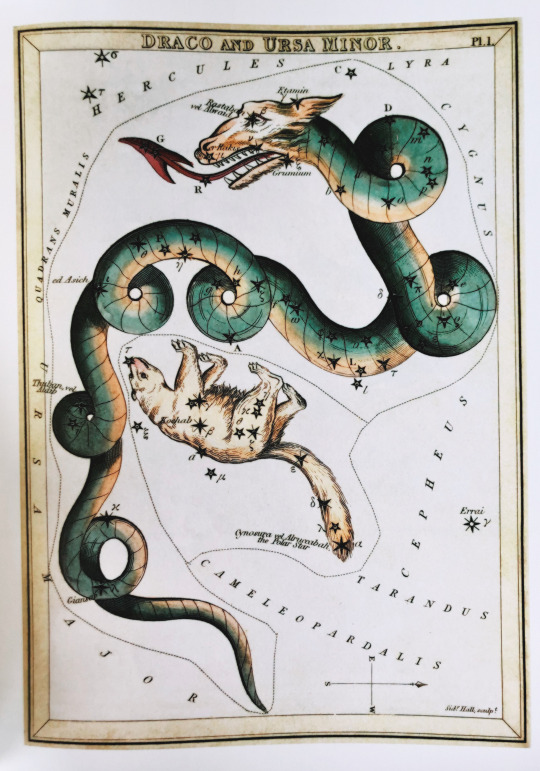
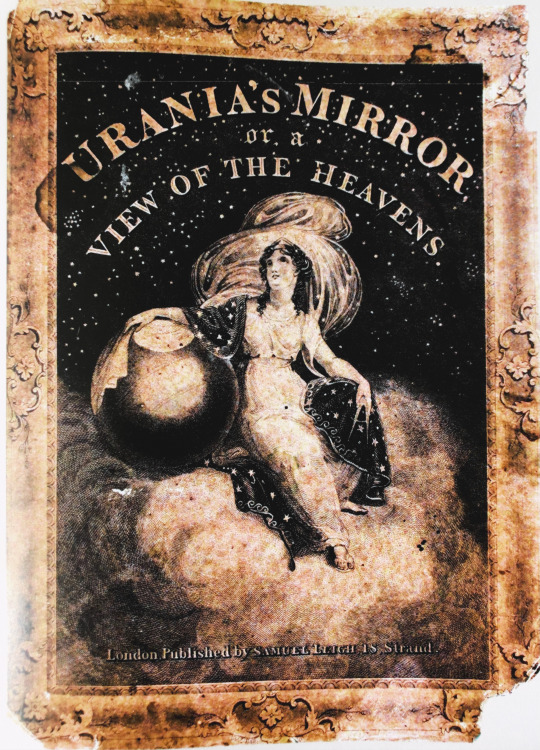
Elena Percivaldi shows the graphically most beautiful and interesting pages of various celestial atlases, often in full-page format and in high quality. The author provides short and knowledgeable captions that explain the necessary context or refer to particular details of the illustration. There are also biographical sketches of the cartographers, which place their work in the context of the history of science.
List of Content
Peter Bienewitz Apian: Astronomicum Caesarum, 1540
Johan Bayer: Uranometria, 1603
Julius Schiller: Coelum Stellatum Christianum, 1627
Andreas Cellarius: Harmonia Macrocosmica, 1660
Johannes Hevelius: Prodromus Astranomiae, 1690
John Flamsted: Atlas Coelestis, 1729
Johann Gabriel Doppelmayr: Atlar Coelestis, 1742
Johann Elert Bode: Uranographia, 1801
Alexander Jamieson: A Celestial Atlar, Comprising a Systematic Display of the Heavens, 1822
Urania's Mirror, 1824
Elijah Hinsdale Burritt: Geography of the Heavens, 1833

17 notes
·
View notes
Text
last line tag game
in a new post, share the last line you wrote and tag as many people as there are words (or as many as you feel like).
got tagged by the most amazing @dudeitiskarev
so this is from a lil something something im writing bc im crazy and i have a carnal need to be with both hotch and spence
"But arousal, specifically female arousal, is not something you can predict, or use algorithms to cause it." Hotch nudged his dress shoe against your heel, spreading it away from the other. "It's a feeling, something that can't necessarily be explained. It just happens. It can't be taught."
"This is where we disagree," Spencer said, and before you could process it, his lips were on your neck.
no pressure tags: @basketonthedoorstepofthefbi @uranometrias @reidrum
11 notes
·
View notes
Text
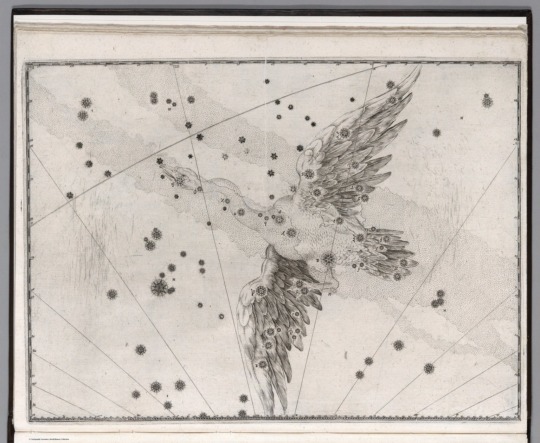
Constellation: Cygnus, the Goose Bayer, Johann (1572-1625)
Publication date 1655
51 unfolded engraved plates of celestial constellations by Alexander Mair. The very rare fourth edition of Bayer's Uranometria (first published in 1603), the first atlas to cover the entire celestial sphere, in fifty-one star charts, including one containing twelve new constellations unknown to Ptolemy. The illustrations are based on Jacob de Gheyn's designs for the Grotius edition of Aratus, published in Leiden in 1600. Johann Bayer (1572-1625) practised as a lawyer in Augsburg, but his principal interest was in the rapidly developing field of astronomy. His most important innovation was a new system of identifying all stars (prior to the invention of the telescope) by Greek and Roman letters, known today as the Bayer designation. The 1655 edition is much rarer than the 1661 edition" (Milestones of Science Books). "Bayer's was the first accurate star atlas. Earlier star catalogues followed Ptolemy's Almagest in using verbal descriptions to describe the location of stars within the 48 northern constellations of classical astronomy, an awkward system that occasioned constant errors and misapprehensions. Bayer, a lawyer and amateur astronomer, was the first to identify the location of stars within a constellation by the use of Greek letters (with the addition of the Latin alphabet for constellations with more than 24 stars). This simple innovation greatly facilitated the identification of stars with the naked eye, just five or six years before the invention of the telescope, and Bayer's stellar nomenclature is still in use today. Bayer used Brahe's recent observations for the northern sky, and included, in chart 49, twelve new southern constellations observed by the Dutch navigator Pieter Dirckzoon Keyzer and reported by Pedro de Medina. To simplify identification of the stars Bayer included in his typographic descriptions both the traditional star numerations within each constellation and the many names for the constellations employed since Ptolemy (Christies). The Uranometria was reprinted in 1639, 1648, 1655 (this copy) and 1661. Constellations largely identified by cataloger.
Deborah Warner, The sky explored: celestial cartography 1500-1800 pp. 18-19
Found in the David Rumsey Map Collection
#astronomy#astro observations#illustration#stars#star map#map#johann bayer#celestial#david rumsey#archive
18 notes
·
View notes
Text
Last sentence tag game
I was tagged by @jellyfishloveletterghosts a while ago and thought I'd participate!
Rules: in a new post, share the last line you wrote and tag as many people as there are words (or as many as you feel like).
If Homelander did come back then he would call Butcher, he definitely would, but right now that wasn't necessary.
He just hoped that it wouldn't become necessary at all.
@tobias-hankel @januaryembrs @uranometrias @aeon-of-neon @brawlite @brillianthijinx
Join in if you want! :)
5 notes
·
View notes
Text
i did participate already @uranometrias but i justttt began writing something else so:
another wip bit:
You might not share blood with Jason, but he did raise you, sort of. It is undeniable how absent he was, for you and Stephen and the woman who took you in as her own.
Even before their divorce, your adoptive dad was always much more worried about the job, and now… Even as you worked with him, his attention always seemed to be on either Hotch or Reid, never you.
Did you hate him? Sometimes. Most times. But you were too self-aware and realized much too young how you craved his approval.
Stephen was smarter than you. He pushed dad away and focused on his own life. You? You sat on an uncomfortable chair at the Seattle field office arguing with mister MIT - Caltech genius as mister FBI super agent and profiler tried shutting you up.
2 notes
·
View notes
Note
I have a question, where do you get your information about the constellations from? I’m a bit of an astronomy nerd and I love your celestial spirit headcanons, do you mind sharing your source(s)?
Good ol' Wikifuckinpedia, my friend. The 88 constellations referenced by Fairy Tail are the IAU-designated ones. The name of the spell "Uranometria" actually comes from a star atlas produced by Johann Bayer.
On the constellation list, you'll find links to every individual constellation, and most of them will also go into the history of the mythological figure (if applicable) that inspired their names.
The benefit of celestial spirits as a concept is that research doesn't have to be incredibly deep; about the most thorough I ever saw was the anime's acknowledgement that Ophiuchus is associated with medicine--this because the snake bearer constellation was said to depict, depending on the stretch of Greco-Roman history you're talking about, either Apollo (god of medicine) or Asclepius (lesser god of medicine who learned medicinal arts from snakes).
Wikipedia is open-source and run on donations. It is held to a higher standard than advertisement-riddled Fandom, and can't be bought by billionaires like Elon Musk, so please remember to support it with a donation if you can.
3 notes
·
View notes
Text
Constellation of the day: a couple words on catalogues and the “naming stars” thing
The number of stars bright enough to be visible to the naked eye from any (any) point on the surface of Earth is around 3000. So it might prove a bit difficult to keep track of whatever’s happening in the sky without the help of a reliable catalogue, that can, e.g., prove essential to identify transient phenomena (like comets, or novae) as such.
In fact, two of the historically most important catalogues (by Hipparchus of Nicea and Tycho Brahe respectively) have as their raison d’être the explosion of a star somewhere near enough to be both visible and a quite strong antithesis to the popular assumption of an immutable cosmos. For more information on historical catalogues, you can start looking here. Or well, on Wikipedia. Paying some attention to the sources.
A number of modern catalogues are available in electronic format and can be freely downloaded from space agencies' databases. The largest is being compiled from the spacecraft Gaia, and has over a billion stars. You can freely download the latest version from the Gaia Archive, just have to find 10TB of space to store it.
Particularly important is the catalogue by Johann Bayer (1572-1625), the Uranometria, first atlas representing the whole sky. Its importance resides in the fact that Bayer, in every constellation, defined the stars of crescent magnitude (let’s say, “apparent brightness”, I’ll come to that too) with Greek letters, switching to Latin letters if the Greek alphabet happened to be insufficient. This practice is now a consolidated one. For example, α Orionis (aka Betelgeuse), brightest star in the Orion constellation. Followed by β Orionis (aka Rigel) and soooo on.
Another special mention goes to the Messier Catalog. Check out the Hubble version.
There are of course a number of conventions now approved by the IAU for naming planets, stars, and any celestial object. Can find everything here, if you’re curious.
Here’s a summary for the “occasional readers”.
The IAU Working Group on Designations & Nomenclature provides guidelines on creating new alphanumeric designations for astronomical objects outside the solar system.
The designations of astronomical source should consist of three parts, that is:
Acronym ^ Sequence ^ (Specifier)
Where ^ denotes a blank. The only optional part is the specifier, that’s to be enclosed in parentheses if present. The acronym is an alphanumerical string of characters that specifies the catalog or collection of sources. It may be constructed from catalog names (NGC, BD, etc.), names of authors (Caswell, WT, RGH…), instruments, observatories, etc. (there are guidelines, dictionaries and hints for that also).
The sequence (numbering) is another alphanumeric string of characters (more often than not only numerical) that uniquely determines the source within a catalog or collection. It may be a sequence number within a catalog, or based on fields or coordinates. The way the sequence is constructed is called the format of the sequence. Also for that, there’s an Inventory of the Formats. And more rules for the usage of coordinates as sequences. Obviously I can’t summarise all that in a post- but I suggest looking that up, if you’d like to make more sense of the names. The the post I hope will come after the next one might prove useful to make sense of the coordinates themselves, and I’ll return to the “use of coordinates in names” matter there.
Now obsolete, the specifier was optional and allowed one to indicate other source parameters. Syntax not required.
Concerning special characters:
• The blanks [ ] are used as separators
• Underscores [_] are used in place of blanks, in case the latter cause problems
• [-] should only be used as a minus sign, for example in coordinates. Other usages are discouraged.
• [.] should be reserved for a decimal point
• [/] should be used for concatenation of the source quoted. Example (same as in the main page of the naming guidelines): “DR 21/23” meaning “DR 21 and DR 23”.
• [:] should be reserved to indicate a subdivision. More rules and practices to be found on the subject.
Now I’ll almost quote the IAU site (I don’t think there’s a better summary and of course the examples are all perfectly fitting):
Stars in binary or multiple systems are labelled by capital letters from the Latin alphabet if the star has a common colloquial name; by Bayer name; by Flamsteed designation; or by a catalogue number. For example, the brightest star in the sky, Sirius (Canis Major), has a white dwarf companion that is catalogued as each of the following: Sirius B, Alpha Canis Majoris B, and HD 48915 B.
Variable stars are nowadays catalogued according to their order of discovery. The first variable to be discovered in each constellation was assigned the letter R and the Latin genitive of the constellation name (I’ll come to that in the next post), such as R Andromedae. The second discovered variable is dubbed S, an then one goes all the way up to Z, beyond which two-letter names are introduced, from RR to RZ, to SS to SZ, up to ZZ. As more variable stars are discovered, the scheme returns to AA to AZ, BB to BZ, and up to QQ to QZ. The letter J is omitted not to be confused with the letter I. So we have 334 possible unique designations for variable stars in a constellation. If even more are discovered, the catalogue turns to designations whereby the constellation name is preceded by the letter V and a number (e.g., V1500 Cygni). The exceptions are those variable stars already assigned a Bayer name, which are not given a new name according to this scheme (for example, Delta Cephei, Beta Lyrae, Beta Persei, or Omicron Ceti).
Stellar explosions called novae and supernovae are transient brightening events. These stellar explosions employ a slightly different alphanumeric system than variable stars. Novae are assigned designations according to their constellation, together with the year their superlumination event occurred (e.g. Nova Cygni 1975), and are later given variable star designations. Indeed, Nova Cygni 1975 refers to the same object as V1500 Cygni, mentioned above, but V1500 Cyg designates the variable stellar system, a cataclysmic binary, and Nova Cygni 1975 refers to its 1975 eruption. Supernovae are also named for their year of occurrence, along with the letters SN and an additional uppercase letter, as in the supernova SN 1987A. A double-lowercase designation is used (e.g., SN 1997bs) if a single year is particularly flush with supernova events. When double-lowercase designations are exhausted, triple-lowercase (e.g. SN 2022hrs) and even quadruple-lowercase designations (e.g. SN 2021afsj) are used.
And that’s everything for now. See ya with the next (shorter) post about constellation names!
~Ad Astra~
0 notes
Link
0 notes
Text
ᴋᴏʀʀᴀ ᴡ/ ᴀ ꜱᴘɪʀɪᴛ-ʙᴇɴᴅɪɴɢ ꜱ/ᴏ





-> synopsis: you're a bender who's dedicated your life to the art of spirit-bending. along the way, you've seem to have caught the eye of a certain avatar.
-> pairing: avatar korra + black!gn!reader
-> contains: pure fluff, 2nd person ('you', 'your', 'yours')
-> a/n: my very mild (not mild at all I am feral atm) obsession with korra has a returned and so you all will now feel the brunt of it lmao. also, semi-new format for the posts? what do we think?
-> join my taglist!
-> tags: @badass-dora-milaje @uranometrias @lees-chaotic-brain @jacuzziwaters

• Morning meditations become a thing, and this is huge because Korra isn't a morning person. If she could, she'd sleep well into the afternoon, but being an all powerful spiritual being that deals with the world's political and humanitarian problems doesn't let you sleep in as often as you'd think. So it's begrudgingly that she adopts an early rise schedule. But upon meeting you, she sees the far earlier morning rises as a way to spend as much time with you as possible, so she cherishes them greatly and learns to love waking up before dawn and heading out to the rooftops to be greeted by the sunrise.
• Does little things she knows that you know aren't like her to do because she wants your special attention. This is usually during training and will consist of her purposefully messing up her form or messing up in the middle of spirit bending (in the beginning this was less of a joke and more of a reality, but as she got better at it, she'd casually play as if she didnt know what she was doing) . Korra will always have this cocky little smirk on her face when you come over to help her, and all you can do is roll your eyes and do your due diligence to the Avatar.
• Korra loves your voice and will do anything to keep you talking. Will ask you history questions about origins of spirit bending or even asks you about theories and hypotheticals to hear you speak passionately on it. On the flip side, she's ironically helpful when it comes to research papers and articles you'd write about Spirit Bending. She doesn't try to distract you but ultimately helps test out your theories and their credibility.
• While protective of you and the dangers that could be faced with accompanying the Avatar, she wants you to come with her on her excursions. You're a valuable asset to the team with your spirit bending, knowing much more than she herself does, and it helps to have an extra set of hands on the job. There's also the added perk of you being a source of comfort for her that she never knew she needed until meeting you.
• Upon being part of the Avatar Krew, a lot of public appearances come with you being at her side as a sort of consultant. With the new age of human-spirit interaction, Korra believes that now, more than ever, the people need more examples of how to handle themselves and how to interact with beings they've only ever heard stories of. Even she admits that your calming presence and knowledge about the spirits as well as how to commune with them has gotten her out of a couple of publicity jams.
• You have matching charm bracelets that glow whenever one of you is spirit-bending, or just bending in general! When she had them carved Korra had no clue that the wooden beads would ever be able to do that, but upon seeing it the first time the two of you spirit bended an agitated dark spirit together, it gave her a revelation of just how deeply bonded the two of you had become during her journey and trials as the Avatar.
• Sleeping together is absolute heaven. After a long day there's nothing either of you want more than to rest in each other's arms. She feels the most comfortable and safe in your shared bed with you next to her, watching over her during the night. After engaging in your wind down routine, which usually either consists of you reading a book and her listening to the pro-bending match on the radio, or both of you talking about your day, snuggling up together under the soft sheets helps you two slip away into sleep in mere seconds.
• With her nightmares, they can sometimes get extreme, and when they do, she may slip into the Avatar State as a defense mechanism. She never feels it herself and at first didn't believe you when you mentioned to her the one time you really caught it; which was when she was sleep on her front with her shirt off one hot summer night and the outline of Rava appeared for a split second, before fading away as you attempted to wake her up. Though around the times of year when those traumatic instances happened, Korra could feel that she was a little tense and her spirit harbored some unease.
• Though not much could be done about those memories and those nightmares, there are times where you feel Korra slip away to meditate to calm her mind. Some times she will break her meditation to see that you've joined her, either with a book to keep yourself entertained and to watch her, or on a blanket next to her in a state of half-sleep.

If you enjoyed, please leave a like, comment, and reblog for others to see! And don’t be shy to send in a request!
#black reader#black tumblr#black avatar#avatar the legend of korra#avatar korra#the legend of korra#tlok#lok#tlok korra#avatar korra x reader#korra#korra x reader#legend of korra#korra x y/n#korra x you
95 notes
·
View notes
Note
I like the information on the celestial realm. Seems interesting especially the place for the constellations 😁 (can't wait for the comic 😍). But, do each group has a leader? For example is Herakles the leader of his constellation group? 🤔🤔
Yes and No. I refer to the ones that live together as 'houses'. Not families. The ones that do not live together are referred to as nothing since there is nothing. However, in Astronomy, the constellations are divided into groups and referred to as families according to Menzel's list (an astronomer). In my story, the ones that are not in a "house", don't refer to themselves as families since they don't live together or are family. This is more of a human concept and ideal like in real life.
Zodiac House- Aries, Taurus, Gemini, Cancer, Leo, Virgo, Libra, Scorpius, Sagittarius, Capricornus, Aquarius, Pisces. Leo is the leader.
Perseus Family- Cassiopeia, Cetus, Andromeda, Perseus, Pegasus, and Cetus (a monster sent to devour Andromeda). Auriga, Lacerta, and Triangulum were also included in Menzel's list. This constellation family do not all live together and thus there is no leader.
Hercules Family- Hercules, Sagitta, Aquila, Lyra, Cygnus, Vulpecula, Hydra, Sextans, Crater, Corvus, Ophiuchus, Serpens, Scutum, Centaurus, Lupus, Corona Australis, Ara, Triangulum Australe, and Crux. This constellation family do not all live together and thus there is no leader.
Orion House- Orion, Canis Major, Canis Minor, Lepus, and Monoceros, located opposite Hercules. Based on Greek mythology, this constellation group shows Orion the hunter, and his two dogs chasing the hare (Lepus). For completeness, Menzel added the unicorn (Monoceros). Orion is the leader. Monoceros does not live with them.
Ursa Major House- The Ursa Major Family includes 10 northern constellations in the vicinity of Ursa Major: Ursa Major itself, Ursa Minor, Draco, Canes Venatici, Boötes, Coma Berenices, Corona Borealis, Camelopardalis, Lynx, and Leo Minor. The eponymous constellation Ursa Major contains the famous Big Dipper. Ursa Major is the leader. However, Bootes does not live with them and Leo minor is missing.
Heavenly Waters House- The Heavenly Waters draw from the Mesopotamian tradition associating the dim area between Sagittarius and Orion with the god Ea and the Waters of the Abyss. Aquarius and Capricornus, derived from Mesopotamian constellations, would have been natural members had they not already been assigned to the Zodiac group. Instead, Menzel expanded the area and included several disparate constellations, most associated with water in some form: Delphinus, Equuleus, Eridanus, Piscis Austrinus, Carina, Puppis, Vela, Pyxis, and Columba. Carina, Puppis, and Vela historically formed part of the former constellation Argo Navis, which in Greek tradition represented the ship of Jason. Eridanus is the leader
Bayer Family- The Bayer Family collects several southern constellations first introduced by Petrus Plancius on several celestial globes in the late 16th century, based on astronomical observations by the Dutch explorers Pieter Dirkszoon Keyser and Frederick de Houtman. The constellations were primarily named for exotic animals reported in the travel journals of that period and were copied in Johann Bayer's influential celestial atlas Uranometria in 1603. The group includes Hydrus, Dorado, Volans, Apus, Pavo, Grus, Phoenix, Tucana, Indus, Chamaeleon, and Musca. Bayer labeled Musca as "Apis" (the Bee), but over time it was renamed. The Bayer Family circles the south celestial pole, forming an irregular contiguous band. Because these constellations are located in the far southern sky, their stars were not visible to the ancient Greeks and Romans. This constellation family do not all live together and thus there is no leader.
La Caille Family- The La Caille Family comprises 12 of the 13 constellations introduced by Nicolas-Louis de Lacaille in 1756 to represent scientific instruments, together with Mensa, which commemorates Table Mountain ("Mons Mensa") in South Africa, where he set up his telescope. The group includes Norma, Circinus, Telescopium, Microscopium, Sculptor, Fornax, Caelum, Horologium, Octans, Mensa, Reticulum, Pictor, and Antlia. These dim constellations are scattered throughout the far southern sky, and their stars were mostly not visible to the ancient Greeks and Romans. (Menzel assigned Pyxis, the remaining Lacaille instrument, to the Heavenly Waters group.) This constellation family do not all live together and thus there is no leader.
#astrite#astrite lore#constellation#This info is from wiki since I didn't know how to explain the historical aspects very well in my own words#But i did want to share the information as I find it interesting and didn't wanna cut anything out. :]#Norma#Circinus#Telescopium#Microscopium#Sculptor#Fornax#Caelum#Horologium#Octans#Mensa#Reticulum#Pictor#Antlia#Hydrus#Dorado#Volans#Apus#Pavo#Grus#Phoenix#Tucana#Indus#Chamaeleon#Musca#Delphinus
1 note
·
View note
Text


Uranometria subunits (CRUX & FORNAX) (11-09 & 07-10-2022)
the illustration for the last subunit, PYXIS, is still in progress
#amara's ocs#uranopro verse#character: ageha#character: shinzou#character: kikyou#character: ginga#character: subaru#character: sakuya#character: hachi#character: junta#2022
0 notes
Text
Open stellar cluster «Manger» — a feeder for celestial donkeys

«Manger» is one of the brightest star clusters in the earth's sky. It is inferior in brightness to the Pleiades and Hyades, but is one of the seven mysterious (obscure in appearance) celestial objects of the Almagest star catalog of Claudius Ptolemy, which means it has been known to people since ancient times.

And what else was there — in this catalog? The Andromeda Nebula, the Orion Nebula, χ-h Perseus (also an open cluster, moreover, a double one), the "Sandal Sole" in Gemini, a stellar association in Coma Berenices constellation (Melotte 111) and the "Ptolemy Cluster", located in the tail of Scorpio, now known as M7 — this is company of the open stellar cluster «Manger» (from Cancer constellation) in ancient times. It can be clarified that it got into the Almagest from the catalog of Hipparchus, who lived 300 years before Ptolemy — in the second century BC. But Hipparchus was not the discoverer of «Manger» — this cluster was mentioned in the writings of Eudoxus of Cnidus (5th century BC). On this, scientific research is lost in the depths of ancient times, but mythological ones remain, which are much more ancient.

Hipparchus
According to Greek mythology — «Manger» — a feeder of the donkeys on which the god of winemaking Dionysus and his faithful companion Silenus went to battle with the Titans. The heart-rending roar of the approaching donkeys distracted the Titans, they lost their vigilance and were defeated by Zeus-Thunderer, who took advantage of the momentary confusion of the enemies. But all the glory went to the donkeys, who, after the end of the Titanomachy, were taken to heaven, turning into the stars Gamma and Delta of Cancer constellation. And so that the donkeys would not starve, the Gods placed a feeding trough right between them — «Manger» — a pale smoky spot, visible only on a moonless night.

Dionysus rides on a donkey to fight the Titans
And it doesn't matter that Dionysus is the last of the Olympian gods to come into being, when the Titans were fall long ago — Greek mythology does not need to be strictly coordinated with linear time. After all, Cancer constellation also appeared in the sky only after Hercules defeated the Nemean Lion ... and this is almost our time — the time of people.
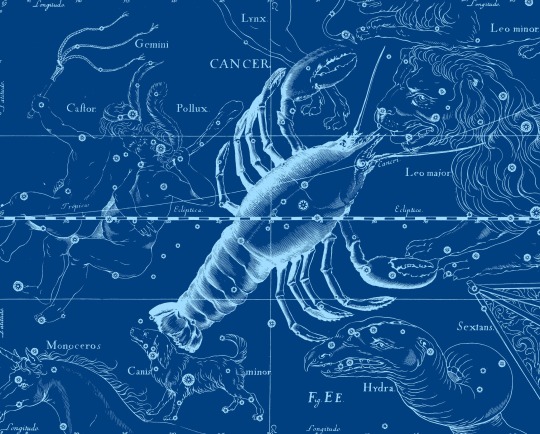
In the view of Chinese and Japanese astronomers of the ancient era, this dim smoky spot among the stars personified the entrance to the afterlife of the departed souls, and caused a feeling of fear.
In "Uranometria" star atlas by Johann Bayer, the «Manger» star cluster was marked with the Greek letter ε (epsilon). By the way, it was Bayer who came up with the designation of stars in Greek letters. But in this case, he applied the introduced rule to foggy objects (although, for example, this did not affect the Andromeda Nebula).
Note: There is another name for this stellar cluster — "Beehive".
A few years after the publication of Uranometria, Galileo Galilei pointed a telescope at «Manger» and separated it into individual stars, counted something about 40 individual stars. Since then, the Greek letter ε refers only to the cluster's brightest star, and the cluster itself received number 44 in the catalog of Charles Messier, a famous comet catcher, who made his catalog with a specific practical meaning — to conduct an all-celestial census of objects that look like comets, but are not comets . In the first edition of the catalog, Charles Messier listed 43 objects, and the Major and Minor Orion Nebulae were listed last. But Charles had a competitor — Nicolas-Louis de Lacaille, who worked on a similar catalog, and in terms of the number of objects "stepped on the heels" of Messier. To overtake his colleague, Charles included two more objects in his catalog just before the press. So in Messier's catalog were «Manger» (number 44) and the Pleiades (number 45). Although, neither one nor the other, when observed through a telescope, has any resemblance to comets.

Charles Messier
Now every amateur astronomer can easily divide «Manger» into individual stars — binoculars or a spyglass are enough for this, and observation of the cluster through a telescope is preferable only at the lowest magnifications so that it can fit in the field of view, because the cluster is very large — 1.5 degrees.

Open stellar cluster M44 «Manger»
By the way, people with exceptional visual acuity can divide the Nursery into separate stars without optics. For some reason, this did not happened in the pre-telescopic era. Have people become more vigilant, or does knowledge give the ability to see more?
It is believed that «Manger» is one of the open stellar clusters closest to the Sun. At the same time, both the Hyades and even the Pleiades are noticeably closer. The Manger cluster is about 600 light-years away — not to say that it is very close. But still, the vast majority of open clusters accessible to amateur telescopes are located much further. For example, the χ-h Perseus double cluster, perfectly visible to the eye, is 12 times farther than the «Manger» — 7500 light years. Compared to this distance, a distance of 600 light years no longer seems so infinite.
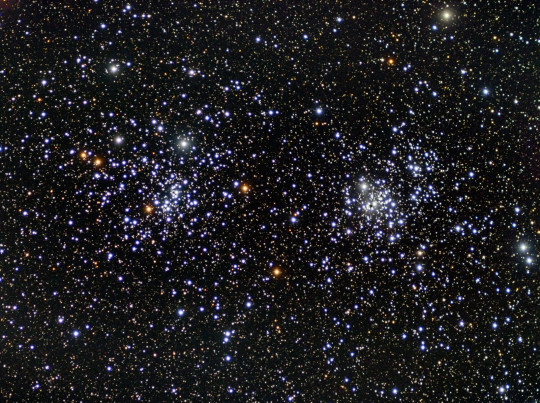
Double open stellar cluster χ-h Perseus
And it's all the more surprising that astronomers have recently revealed a connection between the Hyades (the open cluster closest to us) and «Manger».
Note: I have special articles on the Hyades and Pleiades clusters. I recommend reading them too — to get a complete picture.
The Hyades are 4 times closer to us than «Manger». Between these clusters there is a cosmic abyss of several hundred light-years. But this is now. And 600 million years ago, the stars of these clusters were born from the same gigantic protostellar nebula — similar to the one we now observe in Orion constellation. Of course, there is no trace of those clouds of gas and dust now. And the stars born in them rushed along their galactic trajectories — the Hyades were a little slower, and the «Manger» for some reason turned out to be faster, and for 600 million years (approximately the same age of both clusters) noticeably broke away from their brothers and sisters from another clusters. But the origin of the stars of «Manger» and Hyades clusters is joint.
Both clusters are also close in the composition of the stellar population — they are dominated by cool and already old stars of spectral types K and M with high metallicity. If astronomers managed to discover only one exoplanet in the Hyades, then six are already known in «Manger».
The sizes of the clusters and the number of stars in them are practically the same — about 1000 stars per sphere with a diameter of about 30 light years.
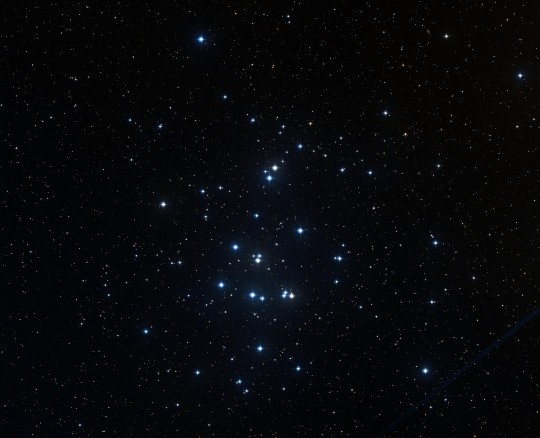
Open stellar cluster M44 «Manger»
At the same time, both clusters are now in a pre-decay state — a significant part of their stellar population has already dispersed into space, and in a few tens of millions of years the rest will also scatter — pretty soon (according to galactic time scales) both star clusters will cease to exist — as subgalactic stellar structures. But many of their constituent stars will roam the expanses of the Milky Way alone for a very long time, because for the most part these are dwarf stars whose life lasts billions of years.
Let me once again shift my gaze to the border of Perseus and Cassiopeia constellations, where a double open cluster is ghostly smoldering, marked on the map by the letters χ and h — how is it not similar to the clusters «Manger» and Hyades? χ-h Perseus — young clusters — they are only 13 million years old, they are located close to each other and fly in our direction. But the speed of their approach is different — 38 and 39 kilometers per second. This means that one cluster is moving through space at least 1 kilometer per second faster than the other. What will happen to them in 500 million years?
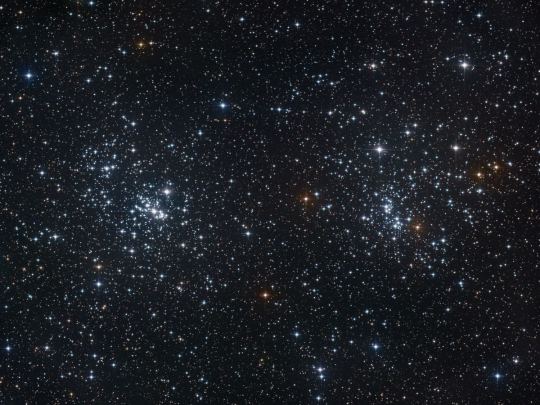
Double open stellar cluster χ-h Perseus
A simple calculation shows that by the time when the age of both the χ and h Perseus clusters reaches the age of the Hyades and «Manger», one cluster will overtake the other by one and a half thousand light years. This is quite correlated with the distance that the Hyades and «Manger» have gained — several hundred light years. This means that we have two typical examples of how stars are born in huge gas clouds, grouped into densely populated open clusters, and then these clusters scatter across the Galaxy, maintaining integrity for at least several hundred million years.
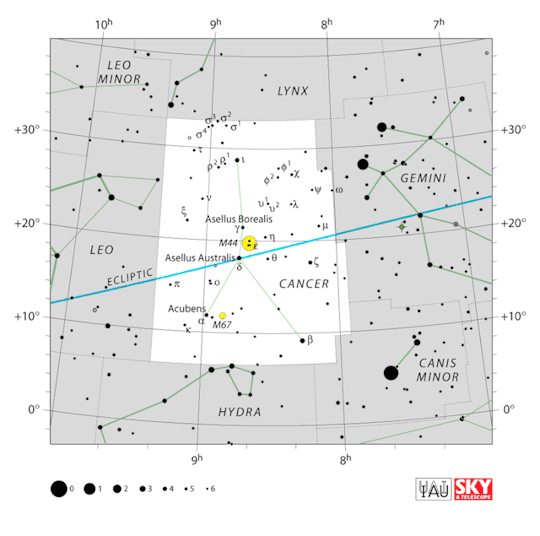
Cancer constellation, in the central part of which the open stellar cluster «Manger» is located, belongs to the group of spring constellations. But the best time for its observations in winter is in January and February. However, Cancer is clearly visible from mid-autumn to mid-spring.
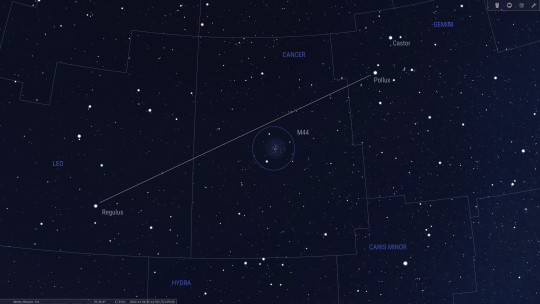
There are no bright stars in this constellation, so the stars of neighboring constellations will help you look for the open cluster «Manger». If you connect the brightest stars of Leo and Gemini constellations — Regulus and Pollux with a straight line, then approximately in the middle of this segment (a little closer to Pollux) you can easily find a compact star scattering with binoculars. And if the sky is dark and transparent, then even with the eye you can see a foggy speck, a little larger than the Moon. In search of the cluster, "donkey stars" will also help you. They still bear their "donkey names" — "Azellus Borealis" (Northern Donkey) and "Azellus Australis" (Southern Donkey). Both stars are significantly closer than the Manger cluster — 3 and 4 times, respectively.
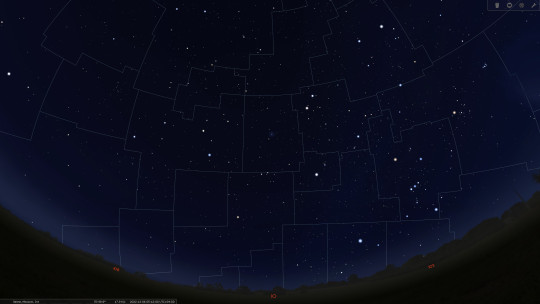
1 note
·
View note
